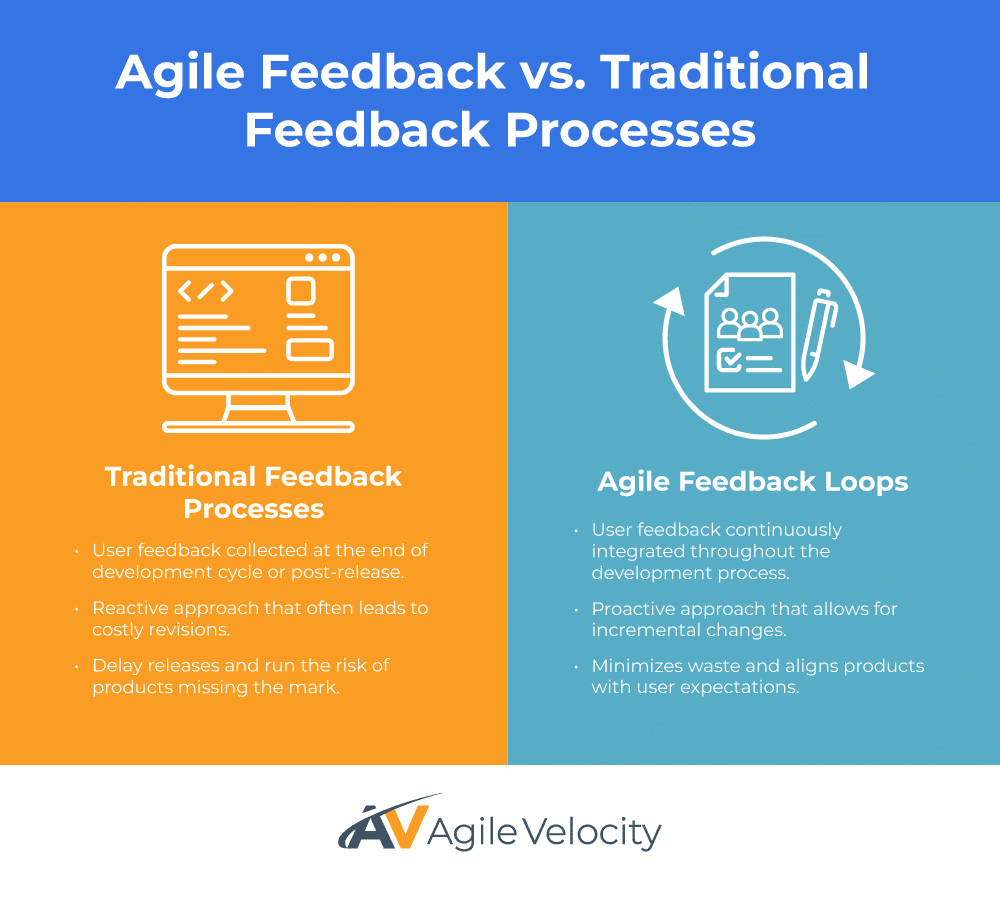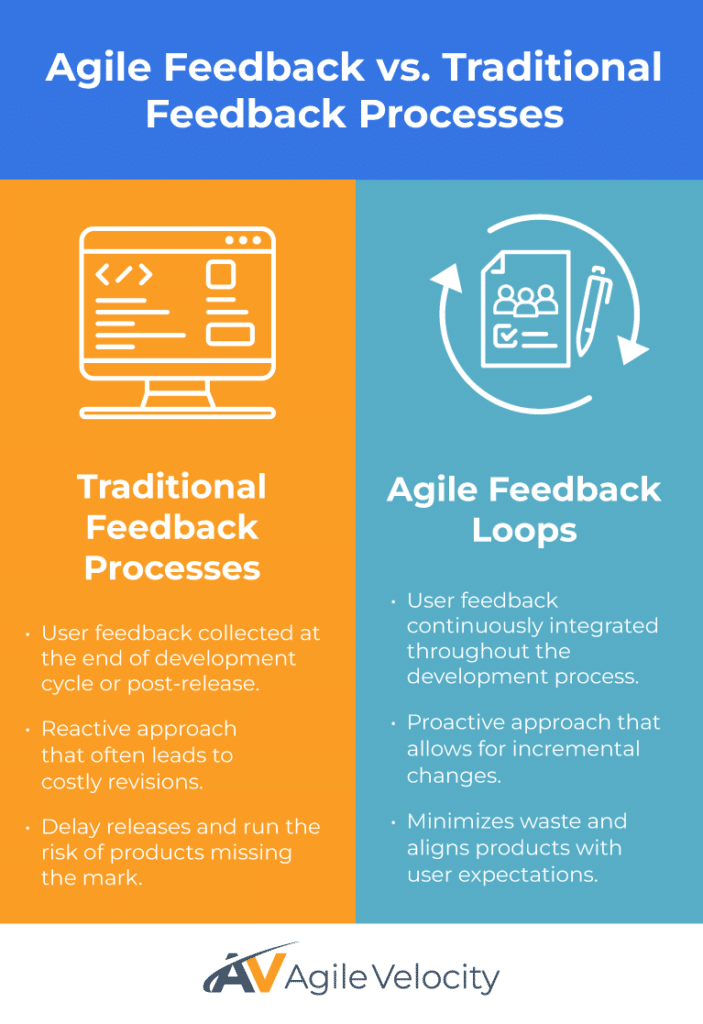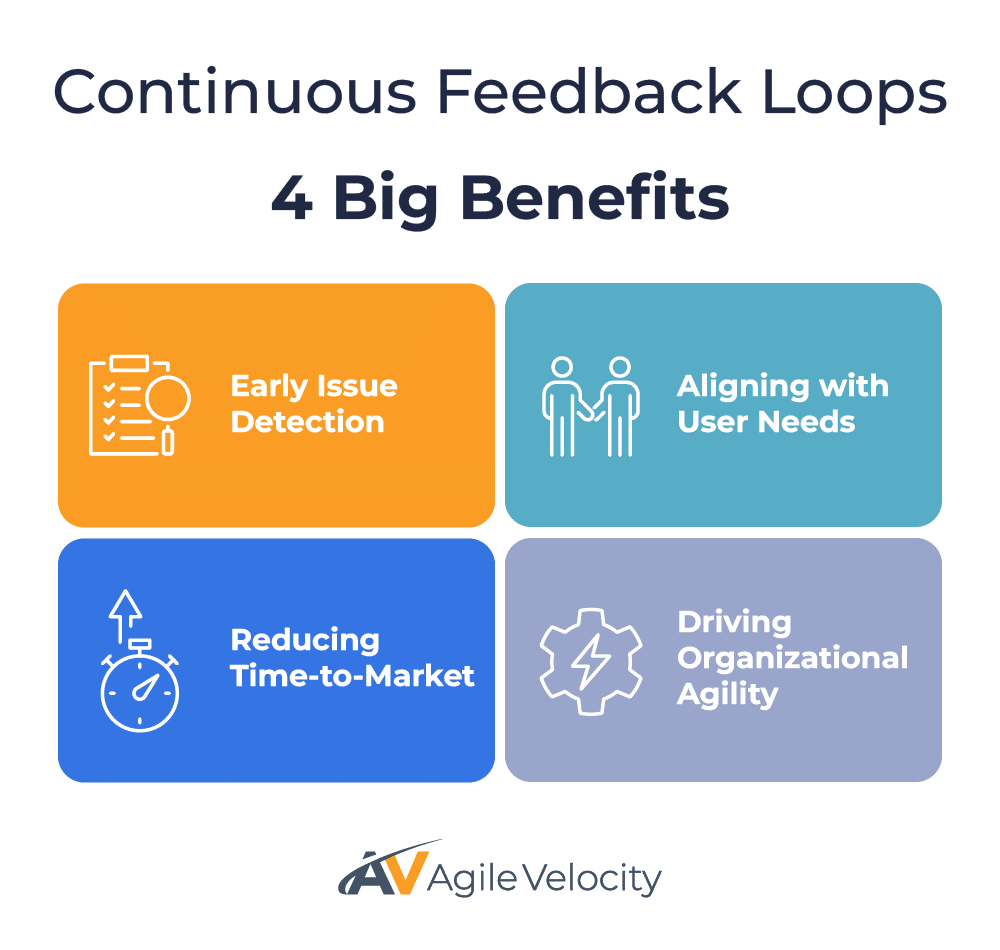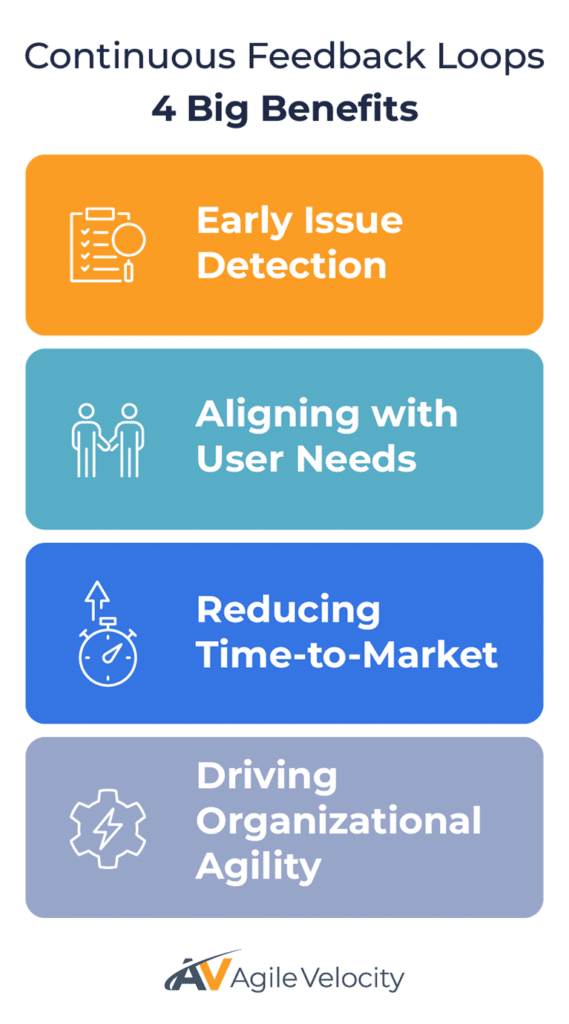Delivering high-quality products that satisfy user needs is more crucial than ever for tech companies aiming to stay competitive. Traditional development methods often fall short in responding swiftly to user feedback, leading to products that miss the mark and users who are left dissatisfied. Enter the Agile Feedback Loop—a dynamic strategy within Agile that prioritizes continuous feedback and rapid iteration. By embracing this approach, teams can enhance product quality and elevate [user satisfaction, keeping development closely aligned with evolving user needs. This article will explore how Agile Feedback Loops can help your teams deliver high quality products aligned with user needs.
The Agile Feedback Loop
The Agile Feedback Loop emphasizes continuous feedback and improvement. It transforms feedback from a one-time event into an ongoing process guiding every development stage.
In the context of Agile Methodology, the Agile Feedback Loop is the practice of collecting, analyzing, and integrating feedback from various stakeholders—including users, team members, and Business Owners—throughout the development process. This loop enables teams to adapt quickly to changes, address issues promptly, and ensure that the final product aligns closely with user expectations.
Principles Underpinning Agile Feedback and Its Role in Agile Practices
At the heart of the Agile Feedback Loop are several key principles:
- Customer Collaboration: Engaging users and stakeholders continuously to gather insights and validate assumptions.
- Iterative Development: Breaking down projects into manageable Sprints or Iterations, allowing for regular assessment and adjustment.
- Continuous Improvement: Regularly reflecting on performance through events like Sprint Retrospectives to identify areas for enhancement.
- Flexibility: Embracing change, even in late stages of development, to meet user needs.
These principles ensure that the Agile Feedback Loop is not just about collecting feedback but actively shaping the development process, making it more responsive and user-centric.
Comparing Agile Feedback Methods to Traditional Feedback Processes
- Traditional: Feedback Processes often involve collecting user input at the end of a development cycle or after product release. This reactive approach can lead to costly revisions, delayed releases, and products that fail to meet user needs.
- Agile: Feedback Loops integrate feedback continuously, enabling teams to make incremental changes and avoid significant overhauls. This proactive approach minimizes waste, reduces time-to-market, and results in products that are more aligned with user expectations.


The Shift from Traditional to Modern Practices in Feedback Handling
Transitioning from traditional to modern feedback handling involves a cultural shift within organizations. It requires adopting an Agile Mindset that values open communication, transparency, and a willingness to adapt. This shift empowers teams to be more innovative, collaborative, and responsive to market changes, ultimately leading to improved products and satisfied customers.
Effective Integration of Feedback into Product Development
Integrating Agile Feedback Loops effectively requires deliberate strategies, the right frameworks, and cultural commitment. Here are practical tips to incorporate feedback within your product development cycles.
Provide Practical Tips for Incorporating Feedback
- Establish Clear Feedback Channels: Designate specific tools and platforms for collecting feedback to ensure it is easily accessible and organized.
- Set Regular Feedback Intervals: Align feedback collection with your development cycles, such as at the end of each Sprint or Iteration.
- Encourage Open Communication: Foster an environment where team members and stakeholders feel comfortable sharing honest feedback.
- Prioritize Feedback: Use prioritization techniques like the MoSCoW Method to determine which feedback items are most critical to address.
- Implement and Review: Act on the feedback promptly and review the outcomes to ensure that changes have the desired effect.
- Facilitate User Workshops: Regular user workshops and focus groups can provide deeper insights into user preferences, allowing teams to make more informed decisions.
Utilizing Agile Roles and Frameworks to Facilitate Feedback Loops
Leveraging Scrum Framework
In the Scrum framework, several key roles and events facilitate effective Agile Feedback Loop integration:
- Scrum Master: Facilitates the process, ensures that feedback loops are maintained, and removes impediments.
- Product Owner: Represents the stakeholders and users, prioritizing the Product Backlog based on feedback.
- Scrum Team: Collaborates on incorporating feedback into the product increment.
Key events include:
- Sprint Planning: Teams plan the work for the upcoming Sprint, incorporating feedback into their goals.
- Daily Scrum: A short, daily event where the team synchronizes activities and discusses any feedback-related issues.
- Sprint Review: The team presents the product increment to stakeholders to gather feedback.
- Sprint Retrospective: A session focused on team processes, where internal feedback leads to continuous improvement.
- Backlog Refinement: Use to gather feedback and clarity on requirements.
Implementing SAFe Framework
The Scaled Agile Framework® (SAFe®) extends Agile practices across larger organizations. Key components include:
- Agile Release Train (ART): A team of Agile Teams working together to deliver value.
- Planning Intervals (PIs): Time boxes during which the ART delivers incremental value in the form of working solutions.
- PI Objectives: Goals that guide the ART, informed by stakeholder feedback.
- Business Owners (BO): Key stakeholders who provide strategic direction and feedback.
SAFe emphasizes alignment and transparency, ensuring that Agile Feedback Loops are integrated at all levels of the organization (SAFe® Guidance).
Learn About the SAFe® Framework
Fast Iteration and Responsiveness to User Input
In the rapidly changing tech environment, the ability to iterate quickly and respond to user input is essential for maintaining a competitive edge.
Highlighting the Significance of Fast Iteration in Enhanced User Experiences
Fast iteration allows teams to:
- Test and Validate Assumptions: Quickly assess whether a feature meets user needs.
- Adapt to Market Changes: Respond promptly to new trends or competitor actions.
- Deliver Incremental Value: Provide users with regular updates that enhance the product experience.
This approach keeps the product relevant and aligns closely with evolving user expectations.
Methods to Foster Responsiveness to User Input Within an Agile Framework
- Continuous Integration and Deployment (CI/CD): Automate the process of integrating changes and deploying them to production, reducing lead times.
- A/B Testing: Experiment with different versions of a feature to determine which one resonates better with users.
- User Surveys and Feedback Tools: Utilize tools that collect real-time user feedback directly within the product.
- Dynamic Prioritization: Regularly adjust the Product Backlog based on user feedback and changing priorities.
Explaining How Agile Teams Use These Techniques to Create Superior Product Offerings
By integrating these methods, Agile Teams can:
- Enhance Product Relevance: Ensure that the product evolves in line with user needs.
- Improve Quality: Address issues before they affect a large user base.
- Increase User Engagement: Demonstrate responsiveness, building trust and loyalty with users.
This proactive stance leads to superior products that stand out in the market.
Build High-Performing Teams
Examining the Impact on Team Dynamics and Organizational Culture
Embracing Agile Feedback Loops positively impacts team dynamics:
- Enhances Collaboration: Teams work closely together, sharing insights and supporting each other.
- Builds Trust: Open communication fosters trust among team members and with management.
- Encourages Innovation: A culture that values feedback is more likely to experiment and innovate.
These cultural shifts contribute to a more productive and satisfying work environment, which can reduce turnover and attract top talent.
Benefits of Continuous Feedback Cycles
Incorporating Agile Feedback Loops into your development process offers numerous advantages that directly impact product quality and user satisfaction.


Improving Product Quality Through Early Issue Detection
Agile Feedback Loops allow teams to identify and address issues early in the development process. By catching defects or misalignments with user needs promptly, teams can avoid costly rework and ensure that the product meets high-quality standards. This results in a more reliable and polished product upon release.
Enhancing User Satisfaction by Aligning with User Needs
When user feedback is integrated regularly, products evolve in direct response to user input. This alignment fosters a sense of partnership between the user and the development team. Users feel heard and valued, leading to increased loyalty and advocacy.
Accelerating Time-to-Market with Agile Feedback Loops
By streamlining the feedback and iteration process, teams can deliver features and updates more rapidly. Agile Feedback Loops reduce bottlenecks and enhance efficiency, allowing organizations to respond swiftly to time-to-market demands and stay ahead of competitors.
Driving Agile Transformation and Organizational Agility
Implementing Agile Feedback Loops is a critical component of Agile Transformation. It promotes Organizational Agility by fostering a culture that is adaptable, learning-oriented, and responsive to change. This agility enables organizations to pivot when necessary and capitalize on new opportunities quickly.
Ready to Delight Your Users?

Embracing the Agile Feedback Loop strategy is a powerful way to enhance product quality and boost user satisfaction. By integrating continuous feedback into your development process, you can create products that truly meet user needs and stay ahead in a competitive market. Agile Feedback Loops facilitate fast iteration, promote responsiveness, and drive organizational agility.
At Agile Velocity, we specialize in guiding organizations through this transformative journey. Our Path to Agility® approach provides the guidance needed to implement effective Agile Feedback Loops and achieve sustainable improvement.
Ready to elevate your product development process? Let Agile Velocity help you harness the power of the Agile Feedback Loop strategy for lasting success.



